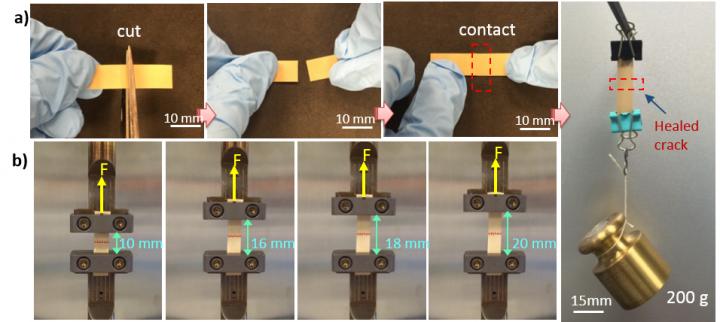
Flexible electronics are a popular research area these days thanks to the many wearable devices on the market. The problem with advancing flexible electronics is that existing materials do not function well after breaking and healing.
However, engineers from Penn State University have developed a new kind of electronic material that can heal all its functions automatically even after breaking multiple times. This material could potentially improve the durability of wearable electronics.
“Wearable and bendable electronics are subject to mechanical deformation over time, which could destroy or break them,” said Qing Wang, professor of materials science and engineering, Penn State. “We wanted to find an electronic material that would repair itself to restore all of its functionality, and do so after multiple breaks.”
What exactly is a self-healable material, you ask? Typically they are materials that can repair themselves, with little to no external help, after withstanding physical deformation like being cut in half. In the past they were created to be able to restore one function after breaking, but it’s now necessary for them to be able to restore multiple functions in wearable devices.

The researchers offer the example of a dielectric material that retains its electrical resistivity after self-healing. If that’s the only function restored, without restoring its thermal conductivity, it could put electronics at risk of overheating.
The material that Wang and his fellow engineers created restores all properties needed for use as a dielectric in wearable electronics: mechanical strength, breakdown strength to protect against surges, electrical resistivity, thermal conductivity and insulating properties.
And while most self-healable materials are soft (with a consistency like a piece of gum), the new material is very tough. The team achieved this consistency by adding boron nitride nanosheets to a base material of plastic polymer. Boron nitride nanosheets are two dimensional, but instead of conducting electricity like graphene (another two dimensional material) they resist and insulate against it.
“Most research into self-healable electronic materials has focused on electrical conductivity but dielectrics have been overlooked,” said Wang. “We need conducting elements in circuits but we also need insulation and protection for microelectronics.”
The material can self-heal because boron nitride nanosheets connect to one another with hydrogen bonding groups that are located on their surface. When two pieces are placed in closely together, the electrostatic attraction naturally occurring between both bonding elements draws them close together. When the hydrogen bond is restored, the two pieces are “healed.”
This self-healing may require additional heat or pressure, but some forms of the new material can even self-heal at room temperature when they’re placed next to each other.
In addition, boron nitride nanosheets can withstand moisture, so devices that use this dielectric material can operate effectively within high humidity contexts like in the shower or at a beach.
“This is the first time that a self-healable material has been created that can restore multiple properties over multiple breaks, and we see this being useful across many applications,” said Wang.
Story via Eurekalert.

Comments are closed, but trackbacks and pingbacks are open.